Story by Noah Kuhn, Adam Kwoh, & Zoe Schlaak
News Editor, Copy Editor, & Staff Writer
Illustration by Tarry Song
Staff Illustrator
South Pasadena’s past exemplifies the United States’ intrinsically racist history: forging a pseudo-democracy on stolen land and constantly working to exclude and ostracize non-white people. The timeline below charts out prominent racist events and examples within this community, but it does not capture the full extent of South Pasadena’s largely undiscussed discrimination.
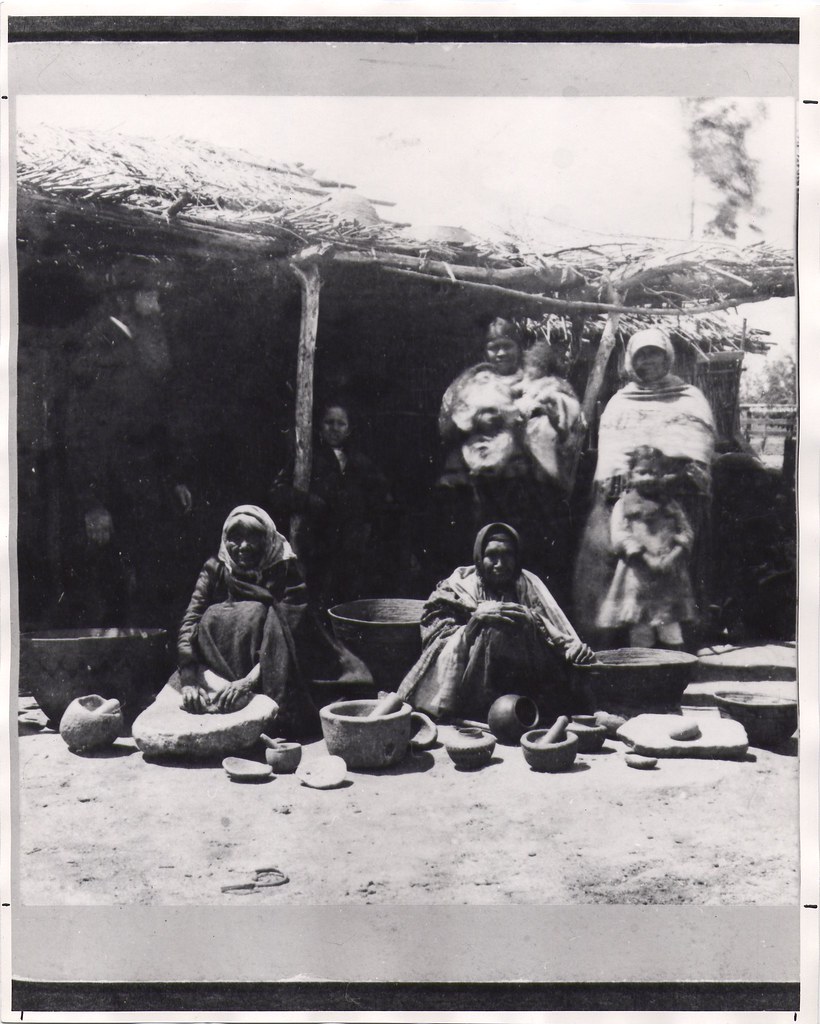
Indigenous inhabitants of the region
South Pasadena was established in 1888 on the ancestral land of the Gabrielino and Tongva tribes. These tribes are the traditional land caretakers of Tovaangar, which is the Los Angeles basin and Channel Islands, and many of them continue to live in the area.
Additionally, the Kawies, also known by the Spanish word Cauhilla, are an indigenous tribe who originally resided in the Great Lakes Region but migrated west once European settlers arrived. They subsequently lived in the Arroyo Seco and San Gabriel Valley until they were forced out by settlers in 1836. In an interview with the South Pasadena Review in 1940, Kawies Chief Tahachwee said that relics found in a burial ground in the Oak Knoll region of San Marino and a moccasin discovered in Elysian Park belonged to his tribe.
Construction of the Arroyo Seco Parkway in 1940 in the Kawies’ ancestral land prompted what local newspapers called a peace offering ritual between the original inhabitants and the white men. Chieftains of many different indigenous tribes gathered in the region alongside California government officials to “relinquish all their rights in the Arroyo” (South Pasadena Review Dec. 27, 1940). Tiger could not uncover any of the tribes’ accounts of the event to corroborate the documented voluntary and peaceful nature of the development and ceremony.

Minstrel show – 1908
South Pasadena residents actively practiced and preached anti-Black racism. The local newspaper at the time, the South Pasadena Record, advertised a minstrel show at St. James Church on July 9, 1908.
City strikes down Black orphanage – 1911
A proposed Black orphanage on Monterey Road in the Lincoln Park neighborhood also stirred opposition from city leaders who moved to enact a ban on orphans’ homes in October of 1911.
The ordinance did not appear to be racially motivated at face value because it did not reference any specific races. However, city officials introduced the orphanage restriction directly following reports of the establishment of a home for Black children and limitations in the law prevented it from impacting the orphanage of the Boys and Girls Club Aid Society, which was whites-only at the time. Local leaders even acknowledged the discriminatory nature of the ordinance.
“Acting City Attorney, Robert Young, advised the board not to be deterred [from] taking any action because fearing defeat [sic]. The proposed ordinance might be defeated or not. It might be held that the city is discriminating against the colored people,” the South Pasadena Record reported on Oct. 20, 1911.
Opposition to Black residents – 1913
Local residents were vocal about their desire to restrict non-white people from inhabiting the community even before city leaders enacted racially restrictive covenants.
“Report that residence is to be erected by negro stirs opposition: A report that G.P. Isaacs of Pasadena, a negro or East Indian, is contemplating building a residence on a lot owned by him at 2011 Mission street… has aroused considerable protest in the neighborhood concerned,” the South Pasadena Record reported on Aug. 26, 1913. “Some residents of the neighborhood are inclined to believe that the reason for the report is that the owners… hope that spreading the rumor of a new colored occupant will induce other property owners to buy out the newcomers at an exorbitant figure. There is marked opposition to the entrance of colored persons into South Pasadena residence districts, which as yet, are practically free from such settlers.”
That same house that Isaacs looked to buy was previously sold to a Black family two years earlier which “aroused the residents in the vicinity, and [they made] efforts… to prevent him from selling to colored people” (LA Times Nov. 3, 1911).
However, the LA Times went on to report in September of 1913 that the “protests of the neighbors were not heeded and about a year ago the house was destroyed by fire, claimed by some to be of incendiary origin.” While there are no sources to corroborate this claim, South Pasadena residents may have indeed resorted to racial violence and terror to exclude a Black family from moving into the city.
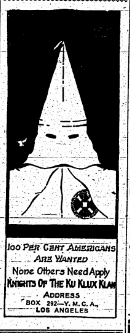
Ku Klux Klan recruiting – 1921
The South Pasadena Courier ran an advertisement that encouraged “100 percent Americans” to apply for the “Knights of the Ku Klux Klan” through a Y.M.C.A in Los Angeles, on July 19, 1921.
Race restrictions campaign – 1940’s
The South Pasadena government codified the town’s racist attitudes through its exclusion campaign in the 1940s, which manifested in restrictive housing covenants. Housing deeds outlining whites-only properties became prevalent in many communities in California, prohibiting people of color from moving into and “disrupting” the racially homogeneous cities.
“South Pasadenans Inc., a city-wide non-profit organization formed a number of months ago with a membership of several hundred civic-minded citizens for the purpose of sponsoring an improvement program set up as a major objective the establishment of race restrictions on property, as a means of preserving values by maintaining the present racial character of the population,” the South Pasadena Review said on Dec. 26, 1941. “The Land Escrow & Safe Deposit Company was engaged to carry on the restriction campaign.”
The race restriction committee then assigned 12 representatives to canvas in each of the city’s 80 apportioned districts to convince the property owners to sign onto the exclusionary policy. Once every homeowner agreed to the whites-only law, it became official in each area and thus eventually in all of South Pasadena. Thurlow Connor, the manager of the local office of the Land Escrow & Safe Deposit Company, recognized that the plan could provoke criticism but was unlikely to be overturned.
“‘Some question has been raised by people concerning the constitutionality of the plan,’ said Mr. Connor. ‘That point has been settled by the Supreme Court of the United States, which has ruled that the use of property can be restricted as to race.’ The cost of restricting property under the plan is $8 a parcel,” the South Pasadena Review reported on Dec. 26, 1941.
Several families of color continued to reside in South Pasadena as the restrictive covenants could not retroactively apply to them.

Japanese internment – 1942
U.S. President Franklin Roosevelt’s Executive Order 9066 mandating Japanese internment significantly impacted South Pasadena. According to an article in the South Pasadena Review dated Mar. 6, 1942, 165 Japanese residents were “forced to move further inland as rapidly as possible… to rid the coast of a potential fifth column threat.” Community members then attempted to use the mandatory evacuation of Japanese families from 17 local homes to make progress on the race restriction campaign.
“Does South Pasadena want undesirables crowding into the homes vacated by alien Japanese?” E. O. Anders, former realtor and member of the Chamber of Commerce, said in a comment to the city according to the the South Pasadena Review’s Apr. 3, 1942 report. “These are in many cases older homes which would not be considered desirable by the average white person, but would soon be snapped up by colored families moving down from Pasadena or surrounding communities… The only suggestion offered at the meeting was that the owners take immediate steps to improve the property in order to remove the danger of surrounding property values being lowered due to an influx of undesirables.”
In 1945, when the federal government allowed Japanese-Americans to go back to their residences, many South Pasadenans were opposed to their return. The South Pasadena Review documented an instance when a store clerk at the old Diamond Market on Mission Street refused to serve a Japanese family who had relocated back into the city.
Lawsuit against local restrictive covenants – 1947
South Pasadena’s racially restrictive covenants became the source of litigation when Ernest and Ethel Chamberlain filed a discrimination complaint against the City in 1947 to force it to remove the “Caucasian race only” clause on their residence on Indiana Avenue. Attorneys from the NAACP, Japanese American Citizens League (JACL), American Civil Liberties Union (ACLU), and the American Jewish Congress (AJC) represented the Chamberlains and charged the South Pasadena government officials, saying they had no right to place race restrictions on property.
The resident majority favored upholding the race restrictions and a local group calling itself the “Protective League” even volunteered to help the City fight the charges of racial discrimination. However, community support proved to be unnecessary as California Superior Court Judge Nourse agreed with the city officials that there was not enough grounds for the Chamberlains to sue, and dismissed the case a few weeks after it was filed in Oct. 1947.
However, in May of the following year, the U.S. Supreme Court ruled that racially restrictive housing covenants were unconstitutional in the case Shelley v. Kraemer. The racist property deeds were never removed and are still visible for many local houses, even though they are not enforceable.
But local sentiment against non-white groups would continue to make it nearly impossible for them to move into South Pasadena. Realtors often refused to show prospective buyers of color any houses and the town essentially became a sundown town with a nightfall curfew for non-white workers in the 1940s.
Limited numbers of Mexican-American and Japanese-American families moved to and resided in South Pasadena in the 1950s, but were usually ostracized by much of the community. Prior to the federally-funded Altos de Monterey development in the mid-1960s, South Pasadena was practically an all white town and the neighboring cities of Alhambra, Highland Park, and El Sereno were comparatively multicultural.
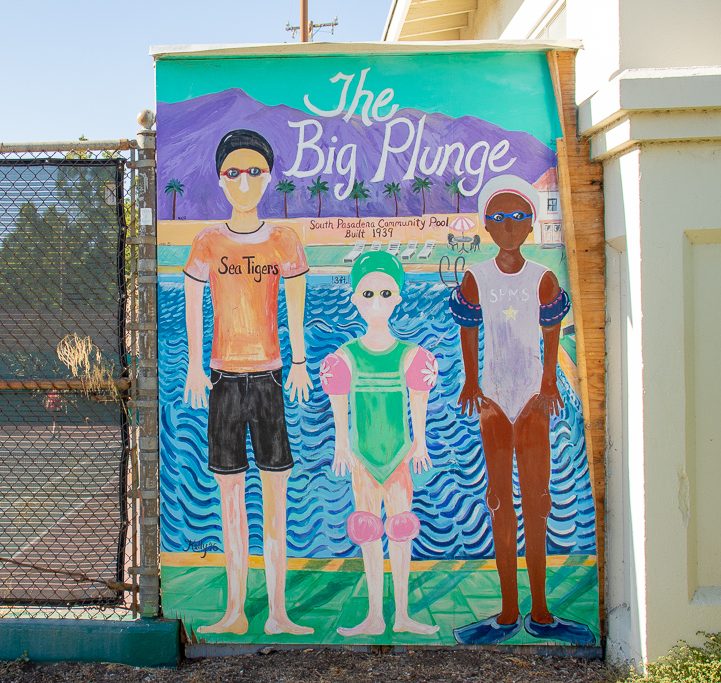
Orange Grove Plunge – 1955
Cross-community racial distinctions escalated into legal conflict regarding the Orange Grove Municipal Plunge South Pasadena opened in July 1939. At first the City allowed non-residents to use the pool regularly, but sometime later rescinded the invitation and only granted them admission as guests of residents or on a by-contract basis. The rule was applied arbitrarily, usually based on the skin color of prospective attendees.
In 1955, a white family residing in Highland Park took a Black friend, Susan McClain, to the plunge and the ticket clerk immediately denied McClain entry. Upon discovering she was with the white family who were also non-residents, the clerk barred them too. McClain filed charges against the City of South Pasadena alleging that it unconstitutionally discriminated against her, but lost in the state appeals court.
The ticket clerk testified that she knew that McClain was not a South Pasadena resident because there were no Black families living in the town at that time. After the court upheld the law barring McClain from the plunge, the City began to issue resident identification cards necessary for admission. However, residents of color have recounted experiences of being thoroughly questioned about living in South Pasadena.
“I remember going [to the Orange Grove Plunge] and them really giving me… my brother, my sister, [my cousins,] and I think maybe even the parents… a hard time about, ‘Well are they really your guests and do you really live in South Pasadena,’” former South Pasadena resident Lorraine Gutierrez said. “We all had our little cards, and eventually they let us in… [but] I just remember feeling really embarrassed… for South Pasadena and… to be in that situation.”
South Pasadena closed and demolished the Orange Grove Plunge in 1979. The city alleged that the facility was falling into disrepair, although many community members have said that it was actually to prevent the access of non-white residents of neighboring communities. In 1978, the school board flattened two houses on Diamond Avenue to erect a swimming pool for the high school, which residents have also reported was to gain a tighter grip on who could use the facility.

Traffic barrier between South Pasadena and El Sereno – 1976
The city council first attempted to close the border between South Pasadena and El Sereno on Via del Rey and Van Horne Avenue in 1973 with a wooden barrier, although motorists quickly destroyed it. The City of Los Angeles won a court order for the removal of the division three days later, but South Pasadena appealed to the California Supreme Court, which ruled that the city could close whatever streets it liked.
The city blocked off the border again in June 1976 for what it called a six-month trial to see if it would lower crime rates and traffic accidents in the area. However, according to the South Pasadena Review’s May report of that year, the Altos de Monterey neighborhood only made up seven, five, and three percent of South Pasadena auto thefts, burglaries, and non-injurious traffic accidents, respectively, since December 1975.
In addition to the lack of evidence necessitating the closure, the city council failed to consider El Sereno residents’ opinions on the barrier. Many living in the Los Angeles neighborhood, which is predominantly Mexican-American and lower income, viewed the traffic block as a racist exclusion effort.
“That ugly barrier is racist,” El Sereno resident Ronnie Solorzano said to the LA Times on June 24, 1976. “Any fence is a cold sign of separation — a sign of keeping people out. We used to drive our kids to the South Pasadena swimming pool, but I guess it’s obvious they don’t want us around.”
In the months following, about 100 protestors gathered at the site of the barrier decrying it as a symbol of racial prejudice. Attorney Richard E. Garcia filed a lawsuit against South Pasadena, asserting the barricade was a 14th Amendment violation and demanding the traffic block be removed. Garcia told the LA Times on Aug. 12, 1976 that “the effect of the barricade was to create a class of people who were excluded from entering South Pasadena and that class of people was based on a racial classification.”
Ultimately, any court proceedings ended in South Pasadena’s favor as the border still remains, today fashioned as a miniature walkthrough park.

City council revisits community divider – 2002
The city council revisited the traffic barrier in 2002 after public pressure in the broader community to remove it, but voted 4-1 to keep yet beautify it into what it looks like today. City officials and residents cited the same speeding and crime-related reasons for keeping the division that were used to support its creation 26 years prior.
However, many people outside of South Pasadena did not see the separation as traffic control. Former El Sereno resident Charles Erickson told the LA Times on Feb. 25, 2002 that the predominantly Latinx community “knew it was a racial barrier, and [that it [amazed him] that they got away with it.” The LA Times columnist who wrote the article quoting Erickson, Al Martinez, explained that even though you may be able to walk through the neighborhood division today, the symbolism of separation continues to ring loud and clear.
“They become cultural barriers of humiliation that linger in the memories of children, who grow up wondering why they weren’t wanted in a neighborhood on the other side of a wall.”
Recent experiences of racism – 2012
In January of 2012, Carla Sameth shared her family’s story with racial intolerance in South Pasadena. Her 7-year-old Black son, Gabe, spent the day at a friend’s home where a 10-year-old child told him that he did not like “n*****s” touching him after Gabe’s hand brushed up against his.
Sameth’s son also informed her of a story within SPHS involving Black students being targeted as suspicious while walking around in a group. After a pep rally, one student reported to the office a group of “black youth” who were walking together, and they were taken into the vice principal’s office and questioned about “what they were trying to do.” The administrator ultimately let the students go but told them to not let it “happen again because kids are worried that you might beat up on someone.”
This reaction is vastly different from when white students walk in groups together and are treated as harmless.

Local legacy of racism lives on – 2020
Stickers with the slogan “It’s okay to be white” (IOTBW) — frequently used by white supremacist groups — were plastered around SPHS on Halloween night in 2018. The IOTBW fliers resurfaced in South Pasadena this past June along with piles of nails left on cars and driveways of residents who publicly promoted the Black Lives Matter movement. Community members have pointed to the lack of teaching the local history of racism as an explanation for its continuance in South Pasadena today.
“Many students are unaware of the racism that has existed in our city from the beginning of the creation of South Pasadena,” junior Frances Lee said. “I, myself, wasn’t aware about the segregation that resides in the history of our city until I joined the [SPHS] Anti-Bias Club. I believe it is important to teach our students about South Pasadena’s history of racism to understand where the racism that exists today stems from and how we can learn from our mistakes.”
Even when students do learn about discrimination and histories of oppression, the instructional lens fails to accurately portray the gravity of the situation and its significance today.
“Often, especially at the lower levels of school—racism is only taught through historical lessons about the biggest or most infamous racists—Certain historical facts can feel like a far off and distant reality,” senior Khalil Murdock said. “What is often not acknowledged is the racism that has taken place locally, and the history of more personal racial biases. I personally believe the teaching of racism in school should become broader in order to give students a perspective on the scope of racism, and it is very important that racism is included in the study of history because it has shaped the historical timeline throughout the world.”


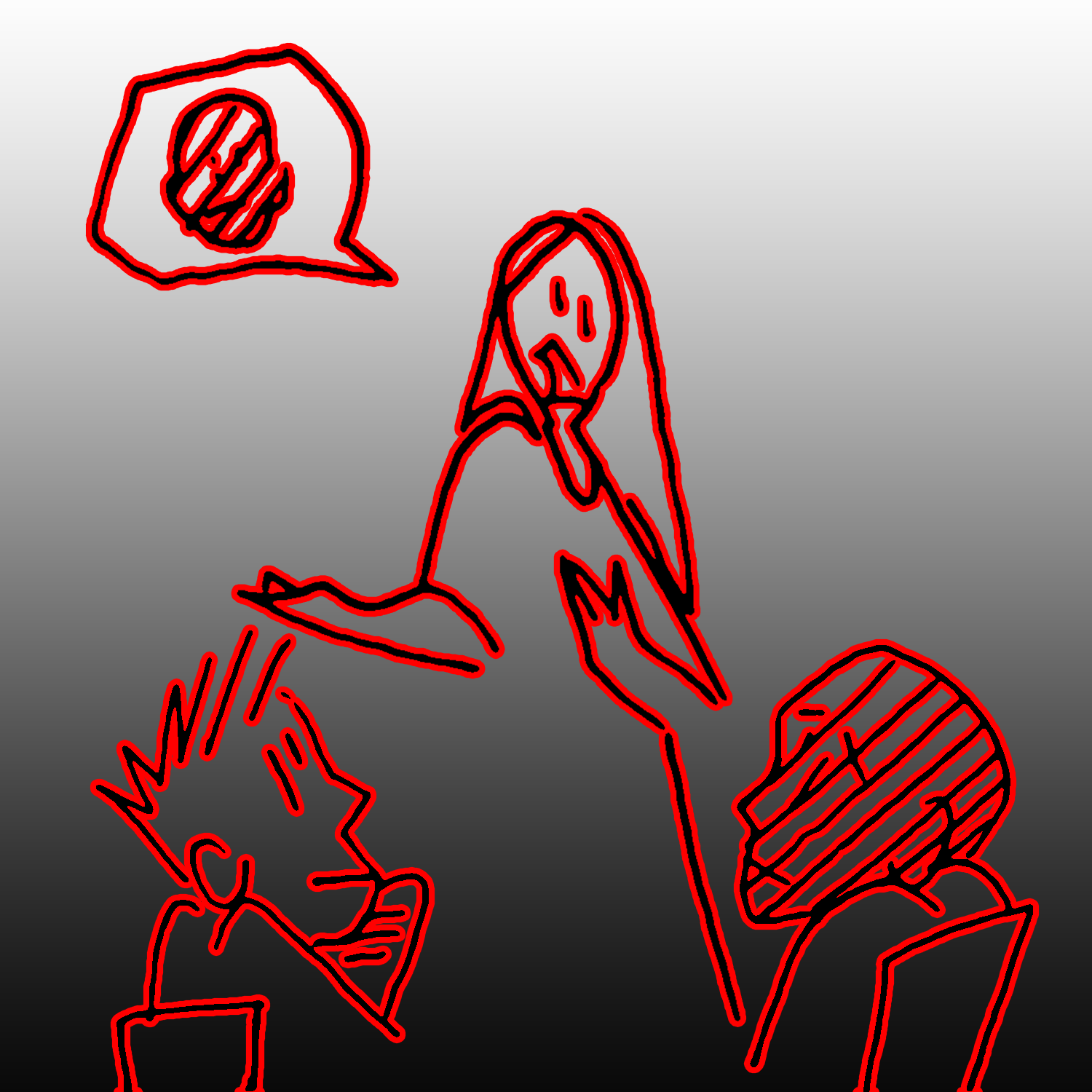
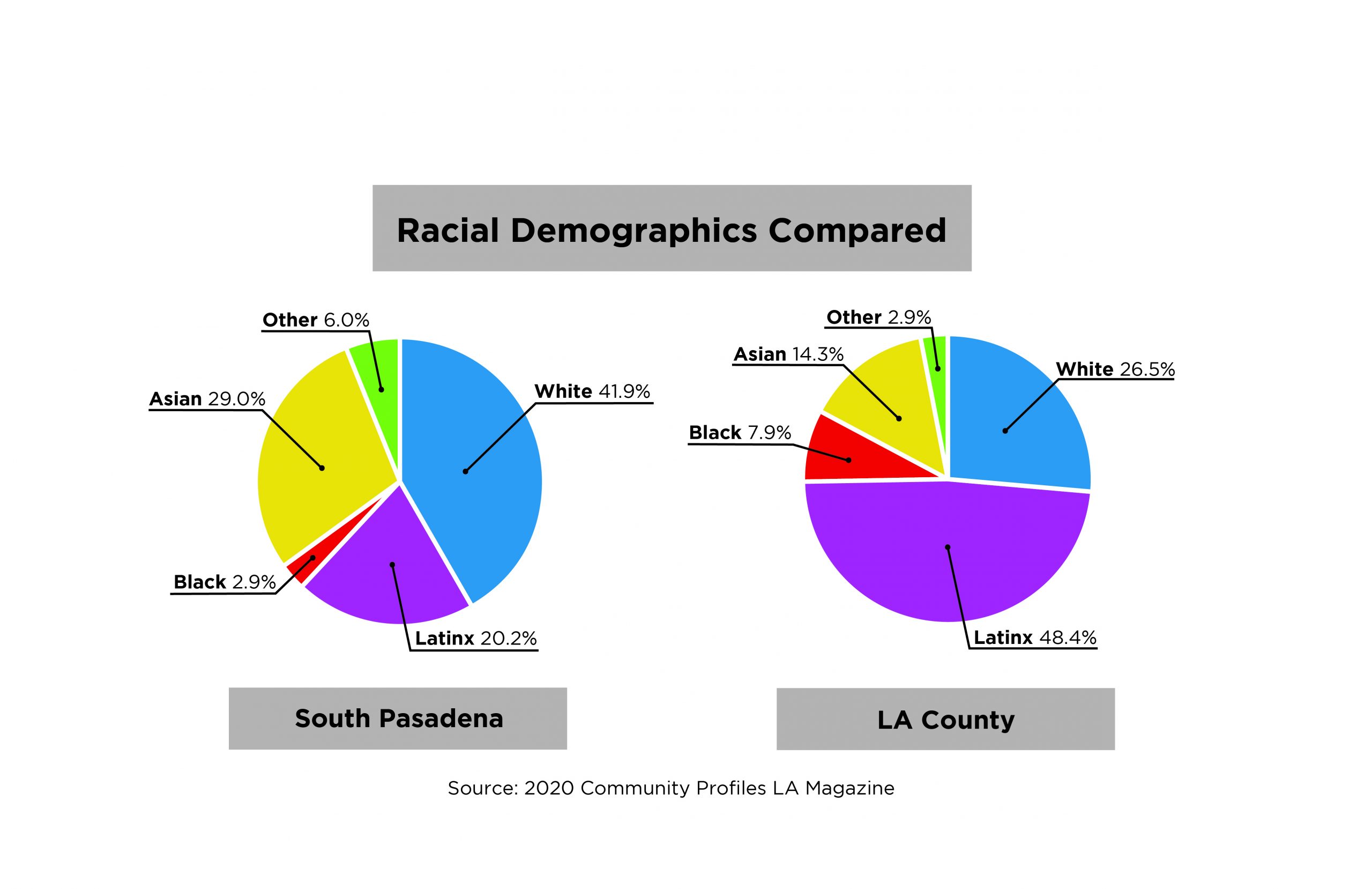
I’m not black, but South Pasadena police were very heavy handed towards anyone who was not a resident back in the late 80s to mid 90s. I was walking through south Pasadena back in 1989 at around 11:00pm. I lived in South Alhambra and was walking from a friend’s apartment on Raymond Hill. I got stopped by a South Pasadena police officer and he asked me what I was doing. I told him “walking home, I live in Alhambra”. He said, without hesitation, “Keep going and don’t stop. You have no business in South Pasadena”. I remember South Pasadena used to have the sign “The Most endangered City in America” posted next to the 110 freeway.
I was born and raised in Pasadena in the mid 1950s but my family moved to nearby Monrovia in 1960 where segregation of black and white communities was defined by a boulevard separating the two. On the white side, however, there was an elementary school attended predominantly by black children. My only memories of seeing black children in the all-white hood was during my observance of dirtclod wars between white boys and black boys. Even though I was too young to recognize it for what it was, systemic racism was very much thriving in the Los Angeles area while I was growing up there. I am thankful I moved away from there at age nine in 1963 and took up residence in racially diverse Albuqerque, NM, where at age 14 in 1968 I helped the first black man, educator Dr. Linton Malry, to become a state legislator by doing door-to-door campaign literature drops. I am again at age 66 in the year 2021 living in the same legislative district where the voters continue to elect a black woman now to represent us. Hallelujah, MLK’s Dream is alive where I live today although I must admit not everything is perfect until we arrange for social and economic justice for people of all colors in the USA.
William L. Johnson,
Southeast Albuquerque Resident
This is a really well written article. Great job. I grew up in South Pas in the 90s and 2000s, from Marengo to SPHS. Had no idea about any of this.
I propose Noah Kuhn’s parents offer their South Pasadena property to descendents of the Gabrieleno Indians. A start, at least, to right past wrongs.
Thank you for digging deep and exposing our city’s history. To combat racism we need to shine a light and educate our community.
Hi Mr. Kuhn! Looking at your well written article and I appreciate the insight. I currrently live in North Pasadena and it is far from racist. But i am considering move to South Pasadena because of a deal I’ve come across. I am a latinx POC and am wondering if I would be shooting myself in the foot. I do like to go on runs and would hate to experience targeting.
This is excellent and brave reporting Mr. Kuhn. If you’re just starting at The Tiger, I look forward to the next three years.